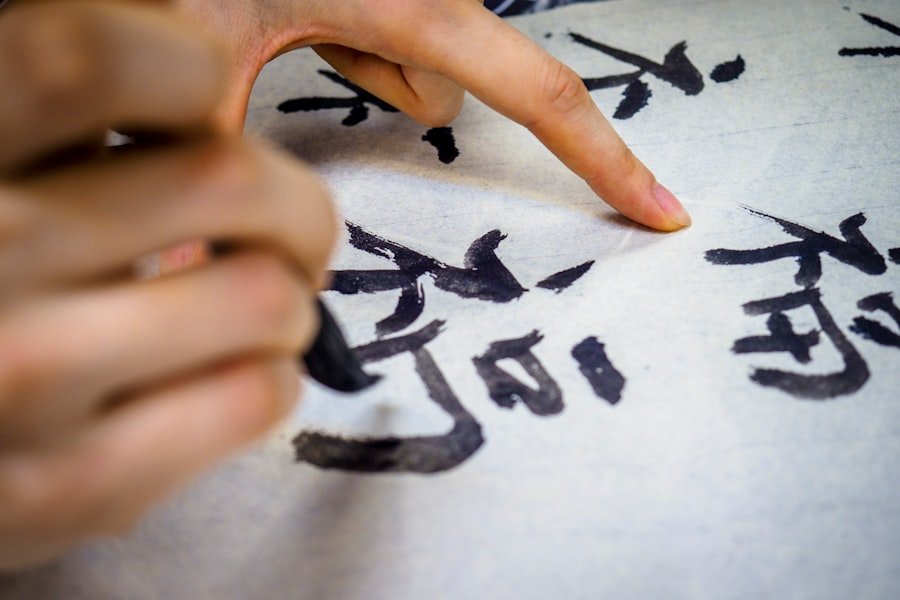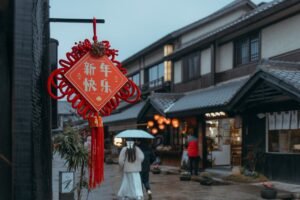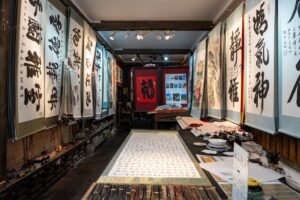Chinese calligraphy, known as shūfǎ (书法) in Chinese, is not merely a way to write characters; it is an art form deeply ingrained in Chinese culture, philosophy, and history. As one of the oldest artistic traditions in the world, Chinese calligraphy has been practiced for more than two thousand years. Throughout the centuries, this art form has evolved into a sophisticated discipline that transcends writing, embodying a reflection of Chinese values, spirituality, and aesthetics.
This article explores the origins, styles, tools, and significance of Chinese calligraphy while also highlighting how this ancient practice continues to inspire both artists and learners today.
Table of Contents
ToggleThe Origins of Chinese Calligraphy
Chinese calligraphy has its roots in ancient China, beginning as a practical means of communication and evolving into a refined art form. The earliest form of Chinese writing can be traced back to the Shāng Dynasty (商朝) (circa 1600–1046 BCE), where jiǎgǔwén (甲骨文), or “oracle bone script,” was carved into bones and tortoise shells. These early characters were used for divination and religious purposes, and they represent the first known example of Chinese writing.
It was during the Qín Dynasty (秦朝) (221–206 BCE), under the reign of Emperor Qín Shǐ Huáng (秦始皇), that Chinese characters were unified across the empire. This unification led to the development of the Seal Script (篆书, zhuànshū), the earliest standardized form of Chinese writing. The Seal Script features rounded and symmetrical characters, which were primarily used for official seals and inscriptions on monuments. Though no longer in everyday use, this script remains significant in Chinese art, especially in the creation of seals.
The Hàn Dynasty (汉朝) (206 BCE–220 CE) saw further developments in Chinese writing with the creation of the Clerical Script (隶书, lìshū). This script was more angular and easier to write than the Seal Script, making it ideal for administrative purposes. Its development was crucial in the evolution of Chinese calligraphy because it allowed for greater fluidity and clarity in writing.
Later, during the Tang Dynasty (唐朝) (618–907 CE), the Regular Script (楷书, kǎishū) became the most widely used form of writing. This script, characterized by its balanced and structured strokes, remains one of the most recognized styles of Chinese calligraphy today. Alongside the Regular Script, the Running Script (行书, xíngshū), a semi-cursive style, and the Cursive Script (草书, cǎoshū), a highly stylized and free-flowing style, also emerged. These styles offered more expressive ways to write, allowing calligraphers to infuse their personal emotions and character into their work.
The Philosophy of Chinese Calligraphy
Chinese calligraphy is not just about writing characters; it is about conveying one’s inner world, thoughts, and emotions. The philosophy behind Chinese calligraphy is closely tied to the broader concepts of Chinese spirituality and self-cultivation, particularly those found in Confucianism, Daoism, and Buddhism.
At the heart of Chinese calligraphy lies the principle of harmony (和, hé). The strokes of each character must be in balance, with the right amount of strength and precision to create a sense of unity between the brush, the ink, and the paper. This concept of harmony extends to the relationship between the artist and nature, as the calligrapher is seen as channeling the energy of the universe through their brushwork.
The practice of calligraphy is often described as a meditative process. The act of writing requires intense focus, patience, and control. The calligrapher must be aware of the flow of qì (气), the life force or energy that is believed to connect all living things. In calligraphy, qì is expressed through the brushstrokes, and the quality of the calligraphy is often judged by the strength and vitality of the lines.
In this way, calligraphy serves as a tool for self-cultivation (修身, xiūshēn). The process of mastering calligraphy is seen as a way to develop one’s character, discipline, and moral values. It is a form of dào (道), or “the way,” a path that leads to inner peace and enlightenment. The act of writing becomes a reflection of the calligrapher’s mind and spirit, and each stroke is imbued with personal meaning.
The Four Treasures of the Study
To practice Chinese calligraphy, one must be equipped with the Four Treasures of the Study (文房四宝, wénfáng sìbǎo), which are the essential tools used by calligraphers. These tools are not only practical but also have symbolic significance in Chinese culture.
- Brush (毛笔, máobǐ) – The brush is the most important tool in Chinese calligraphy. It is traditionally made from animal hair, such as that of goats, rabbits, or wolves, and attached to a bamboo handle. The flexibility of the brush allows for a wide range of expression, from thin, delicate strokes to bold, sweeping lines. The quality and type of brush used can greatly affect the outcome of the calligraphy.
- Ink (墨, mò) – Ink in Chinese calligraphy is typically made from a combination of soot and resin, which is then formed into inksticks (墨块, mòkuài). The calligrapher grinds the inkstick on an inkstone (砚台, yàntái) with water to produce the ink. This process of grinding is often considered an important ritual, as it prepares the calligrapher mentally and spiritually for the act of writing.
- Paper (纸, zhǐ) – The paper used in Chinese calligraphy is usually rice paper or xuānzhǐ (宣纸), known for its absorbency and smooth texture. The type of paper chosen can influence the style of writing, as different papers react differently to the ink. High-quality paper is prized for its ability to capture the fluidity of the brushstrokes.
- Inkstone (砚台, yàntái) – The inkstone is used to grind the inkstick into liquid ink. It is an essential part of the calligrapher’s toolkit, and the quality of the inkstone can affect the consistency of the ink. Inkstones are often carved from fine stone, and their craftsmanship is considered an art form in its own right.
These four treasures are more than just tools; they are revered objects that have been used by generations of Chinese scholars, artists, and poets. Mastery of these tools is essential for producing beautiful and expressive calligraphy.
Styles of Chinese Calligraphy
Over the centuries, Chinese calligraphy has developed a variety of styles, each with its own unique characteristics and artistic qualities. The major styles of Chinese calligraphy are:
- Seal Script (篆书, zhuànshū) – The earliest standardized form of Chinese writing, used during the Qin Dynasty. This script is characterized by its rounded and symmetrical characters. Seal Script is no longer in common use but is still used in official seals and stamps.
- Clerical Script (隶书, lìshū) – Developed during the Han Dynasty, Clerical Script is more angular and horizontal than Seal Script. It was primarily used for official documents and inscriptions. The simplified, straight lines of Clerical Script make it easier to read and write, marking a turning point in the evolution of Chinese writing.
- Regular Script (楷书, kǎishū) – One of the most widely recognized styles of Chinese calligraphy, Regular Script became the standard form of writing during the Tang Dynasty. It is known for its clear structure, balance, and precise strokes. Regular Script is still used today and is considered one of the most accessible styles for learners.
- Running Script (行书, xíngshū) – A semi-cursive style of calligraphy that developed alongside Regular Script. Running Script allows for more fluid and natural writing, with characters connected in a way that mimics the flow of thought. It is often used for personal correspondence and artistic expression.
- Cursive Script (草书, cǎoshū) – The most expressive and free-flowing of all the calligraphy styles. Cursive Script allows for quick, spontaneous writing, with characters often reduced to their simplest forms. This style is highly abstract and is used by skilled calligraphers to convey emotion and individuality.
Each of these styles offers a window into the artistic and cultural evolution of China. By studying these different forms, one can gain a deeper understanding of the richness and diversity of Chinese calligraphy.
The Cultural Significance of Chinese Calligraphy
Throughout Chinese history, calligraphy has played a central role in cultural and intellectual life. It has been associated with scholars, poets, and philosophers, who viewed it as a means of self-expression and a reflection of their moral character. Calligraphy was an essential part of the imperial examinations (科举, kējǔ), which determined who could hold government positions in ancient China. Mastery of calligraphy was seen as a reflection of one’s intellectual abilities, discipline, and refinement.
The connection between calligraphy and Chinese philosophy is also profound. Confucian scholars emphasized the importance of self-cultivation (修身, xiūshēn) and moral integrity, both of which were reflected in the practice of calligraphy. Daoism, with its focus on harmony with nature and the flow of qì (气), also played a significant role in shaping the philosophical foundations of calligraphy. For Daoists, the act of writing was a way to align oneself with the natural world and achieve spiritual enlightenment.
In addition to its intellectual and philosophical significance, calligraphy is also considered one of the Six Arts (六艺, liù yì) of Chinese culture, alongside ritual, music, archery, chariot racing, and mathematics. These arts were considered essential for the education of gentlemen in ancient China, and mastery of calligraphy was seen as a marker of refinement and cultural sophistication.
Today, calligraphy remains an important aspect of Chinese culture and education. It is taught in schools, practiced by artists, and admired by people from all walks of life. Calligraphy is also a popular hobby for those seeking a meditative and artistic outlet, as it allows for the expression of both intellectual and emotional depth.
Chinese Calligraphy Today
Despite its ancient origins, Chinese calligraphy continues to thrive in modern times. Artists around the world are incorporating calligraphy into contemporary art, blending traditional techniques with modern styles and materials. In China, calligraphy is still practiced by both professionals and amateurs, and it is regarded as a valuable cultural heritage that should be preserved and passed down to future generations.
At LC Chinese School in Oslo, we understand the importance of preserving this ancient art form. That’s why we offer specialized courses that teach the fundamentals of Chinese calligraphy alongside language learning. Whether you are a beginner looking to explore the basics of calligraphy or an advanced student seeking to refine your skills, our flexible classes are designed to cater to your individual needs.
If you’re passionate about learning Chinese calligraphy or exploring the language itself, register for our Chinese classes at LC Chinese School in Oslo today!
Why Learn Chinese Calligraphy?
Learning Chinese calligraphy is more than just acquiring a new skill; it is an opportunity to engage with one of the most ancient and revered art forms in the world. It is a deeply enriching experience that goes beyond language learning, allowing students to immerse themselves in Chinese culture, history, and philosophy.
Calligraphy fosters patience, creativity, and discipline, making it a powerful tool for personal growth. It provides a unique way to practice mindfulness, as each stroke requires focus, precision, and an understanding of the character’s structure. Through the study of calligraphy, students gain insight into the beauty and complexity of Chinese characters, while also developing a deeper appreciation for Chinese culture.
At LC Chinese School, our calligraphy courses are integrated into our language programs to provide a holistic approach to learning Chinese. Whether you’re looking to understand Chinese culture on a deeper level or simply want to improve your handwriting, our courses are designed to be both enjoyable and educational.
Register for Chinese classes at LC Chinese School in Oslo and begin your journey into the art and language of China!








